Figure 11-29.—Agitating a small developing tank.
(fig. 11-29). The initial agitation should be 30 seconds.
Place the tank in the sink on its bottom (cover up).
4. Once every minute, agitate the film for five
seconds by slowly inverting the tank end to end. After
each agitation cycle, place the tank back in the sink. If
the tank is held during the entire developing period, the
heat from your hands may heat the developer and
produce unpredictable results.
5. When only 10 seconds of developing time
remain, remove the cap from the tank cover.
Immediately start pouring the developer out of the tank
through the light trap pouring hole. Dispose of the
chemicals according to the local instructions of your
imaging facility. This step should take about 10 seconds
to complete.
6. When the developer has been emptied from the
tank, fill the tank to overflowing with stop bath. The stop
bath must be poured into the tank through the light trap
pouring hole in the tank cover. Replace the cover cap.
Agitate the film in the stop bath for about 30 seconds,
using the end-to-end method.
7. When the stop bath portion of the process is
complete, pour the stop bath through the light trap hole
in the tank cover.
8. With the tank rover still in place, pour fixer into
the tank and replace the cap. Dislodge air bubbles and
set the timer to the required fixing time. Start the timer
11-32
and agitate the film, using the same agitation as the
developer.
9. When the prescribed fixing time has elapsed,
remove the tank cover and pour the fixer from the tank
back into the bottle from which it came. Never pour the
fixer into the sink. The fixer can be reused and then
saved for silver recovery.
10. The film can be washed either in the tank or in
a roll film washer. If the tank is used, insert a hose down
through the center of the reels until it is about one-half
inch from the bottom of the tank. Adjust the water (at
the same temperature the film was processed) so a
steady overflow is created. Wash the film for about 20
minutes.
11. While the film is washing, rinse the processing
tank, tank cover and cap with clean water. Fill the tank
with water (check the temperature) and add the wetting
agent. After the film has been washed, place the film,
still on the reels, into the wetting agent solution. Replace
the tank cover and cap and agitate the film in the wetting
solution very slowly for one minute.
12. After one minute in the wetting solution,
remove the loaded film reels from the tank (Do not save
the wetting solution.)
13. To dry the film, attach the end of the film to a
clip in the drying cabinet (fig. 11-30). Let the film
unwind from the reel as you slowly lower the reel.
When the film is unwound, depress the grip clip (if
the reel has one) or remove the film from the core of the
reel. Squeegee the film and attach a second film clip to
the lower end of the film. Close the drying cabinet door
and dry the film.
CLEANING UP
After processing, the darkroom and all equipment
must be cleaned up immediately. Rinse thoroughly all
processing equipment: tanks, reels, thermometers,
funnels, and soon, in clean, warm water. Place the clean
equipment where it can dry before it is needed for the
next processing project. Always leave the darkroom
spotlessly clean and in good order.
CONTACT PRINTING
LEARNING OBJECTIVE: Recognize the
purpose of contact printing, identify the
required contact printing equipment, and
determine the procedure used in contact
printing.

